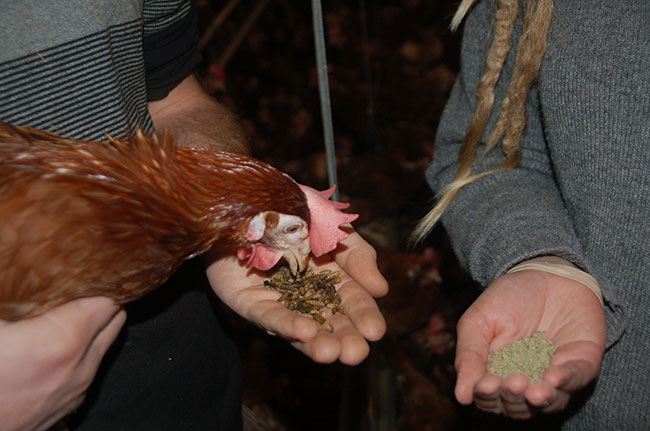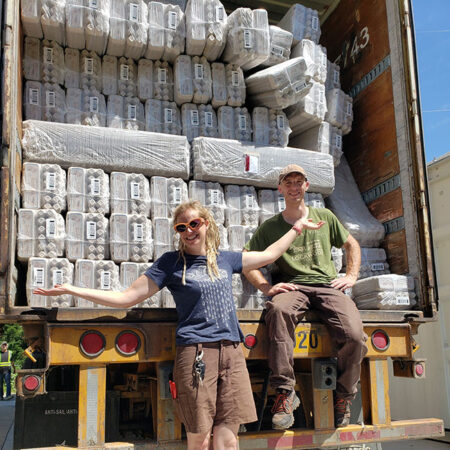
Is insect feed sustainable?
By Treena Hein
Features Nutrition and FeedNew research to assess overall impact of feeding poultry black soldier fly larvae. Meanwhile, progress on breeding
 UBC researcher Daniela Dominguez is currently doing a life cycle assessment of using black soldier flies to feed laying hens. PHOTO CREDIT: Lockwood Farms
UBC researcher Daniela Dominguez is currently doing a life cycle assessment of using black soldier flies to feed laying hens. PHOTO CREDIT: Lockwood Farms Use of insects as a food source for commercial poultry is well underway in North America, Europe and Australia. Insects are a natural food source for birds and many other animals and the sustainability of using insects like black soldier fly larvae (BSFL) in feed is high. BSFL are very efficient feed converters – and they are fed food waste that would have gone to the landfill site. Their production, therefore, requires no dedicated crop production.
The first layer farm in Canada to include BSFL in its ration was Lockwood Farms on Vancouver Island. They won the Outstanding Young Farmers Award for B.C. in 2019 for this and other innovations such as generating all electricity needed with on-farm solar production.
Their eggs are branded as EcoEggs and sold in specialty retail stores and restaurants in the Victoria area. “We produce about 5,800 a day and the retail price is in line with organic eggs, generally about $7.50 for a dozen large,” farm co-owner Cammy Lockwood says. “We tend to get more medium eggs than large. We’ve noticed feather coverage is better and for longer in the life of the hens.”
They’ve been using BSFL from B.C.-based Enterra, but due to supply and cost issues, including high cost of transportation, they are looking into producing their own.
Enterra began BSFL production in 2007 using pre-consumer waste food collected from farms, grocery stores and food processing. The larvae are dried and processed into three products: EnterraGrubs (whole BSFL); EnterraProtein; and EnterraOil.
Sustainability research
In terms of just how much the sustainability of BSFL exceeds other conventional poultry feed ingredients such as grains, new research is about to provide greater insight.
Daniela Dominguez, a master’s student at University of British Columbia under the supervision of Nathan Pelletier (and part of the Food System PRISM Lab), is currently doing a life cycle assessment (LCA) of using black soldier flies to feed laying hens. She recently presented her project at the Canadian Poultry Research Forum.
The scope of Dominiguez’s study is cradle-to-farmgate, including the production and processing of the BSFL, the production of the insect-based feed and its distribution to and use on egg farms.
Dominguez is working with data from EnviroFlight, a U.S.-based BSFL firm. Using this producer as a case study, Dominguez is currently building LCA models, which will enable her to identify hotspots and evaluate opportunities to improve the environmental performance of BSFL through energy-efficiency measures and assess the use of BSFL meal in the context of sustainable feed formulation.
“I will be comparing BSFL meal to conventional feed ingredients,” she says, “in order to identify the potential to reduce the environmental impacts of egg production by using BSFL as a feed input.”
In terms of potential opportunities in energy efficiency that would further improve the sustainability of BSFL, Dominguez says that the breeding and processing of BSFL are the stages with the highest environmental burdens due to electricity and natural gas required.
“Therefore, I will first compare the pilot and commercial facilities to determine if a larger scale of production represents an improvement in efficiency and to understand the extent to which efficiencies have already evolved in the EnviroFlight facilities,” she explains.
“Next, using the commercial scale facility as the baseline, I will model and assess different scenarios to determine the possibility of optimizing energy efficiency at key process stages. For example, by implementing different technologies such as new drying processors or heat recovery ventilators, as well as by using renewable energy sources.”
Dominguez says the diet of the BSFL is also an important element in the production system regarding environmental impact (as well as nutritional profile).
To address this aspect, she will also be looking at the use of food waste and processing by-products as well as other rearing substrates.

Vancouver Island’s Lockwood Farms sells EcoEggs, which are laid by hens fed black soldier fly larvae and in a barn that uses solar power.
Genetics advances
In July, collaborators Hendrix Genetics and Protix shared exciting news about BSFL sustainability when they announced major breeding progress. They recently published results of a two-year breeding selection project in the journal Frontiers in Genetics that shows heavier larvae with more protein and fat harvested per crate.
Hendrix has stated that it conducted this research because of the exponential growth in BSFL farming and “a need to further improve the efficiency of production to meet the rising demands for proteins in the feed and food industries under limited resources.”
The team selected for body weight and that genetic line was compared to a base population line over six experimental rounds under different environmental conditions. Under automated production settings, an average increase of over 39 per cent in larval weight was achieved, along with a 34 per cent increase in wet crate yield, 26 per cent in dry matter crate yield, 32 per cent in crude protein per crate and 21 per cent crude fat per crate.
Noting that exploring potential changes in genetics as a sustainability factor is outside the scope of her current research, Dominguez does believe that genetics could play an important role in the sustainability of BSFL and other types of insect farming if it improves the feed conversion ratio, reduces mortalities rates, or otherwise contributes to improved efficiencies.
“Certainly, improved genetics have been a key lever in reducing environmental impacts in other animal production contexts,” she says.
Dominguez says that BSF has the potential to become a sustainable input for poultry feed due to its high nutritional qualities and its capacity to convert bio-waste into valuable products. Still, she adds that the potential net benefits will be highly dependent on numerous factors.
“Overall, I think that there is a lot of potential here, but that a lot of research as well as technological innovation and maturation will be necessary before we can draw conclusions.”
Print this page